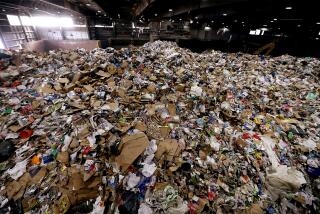Antarctica’s Biggest Town Turns Green
- Share via
McMURDO STATION, Antarctica — Condemned by environmentalists just a few years ago as one of the most polluted spots on Earth, this scientific community has come a long way toward cleaning up its act.
McMurdo, home to 1,200 people in summer and 250 in winter, used to burn trash in open pits on the hill overlooking the town. Garbage was plowed into landfills that provided a rich feeding ground for skuas, the Antarctic sea gulls that love food scraps.
“Mac Town” won’t win any beauty prizes. Most of its residents compare it to a mining camp, with its warehouse-like buildings and muddy dirt roads.
But a new waste management program has had a major effect on McMurdo’s impact on Ross Island--and on the residents. This could well be the most environmentally conscious American town anywhere.
Even the activist group Greenpeace gives McMurdo credit for cleaning up, particularly for shutting down an incinerator last year that was emitting too much pollution. But the environmental group is not pleased with McMurdo’s urban sprawl and the legacy of past mismanagement, such as old landfills.
In the last two years, Antarctic Support Associates of Englewood, Colo., has introduced a crash program to minimize nonessential materials being brought in, to separate trash for recycling, and to reuse every item possible. What is left over is shipped out for disposal.
“We’ve been taught that the world is a small place,” said Eric Juergens, the safety, environment and health supervisor for the three Antarctic stations managed by Antarctic Support Associates in support of the research done by the U.S. National Science Foundation.
If carrying out the garbage meant you had to lug 3,750 tons of trash over 10,000 miles to the dump, you’d probably try to cut down on your waste too.
That is how much trash ASA shipped back to Indian Island, Wash., for disposal last year, including 95 tons of hazardous waste. The current disposal cost is six cents a pound, a total trash-hauling bill of about $450,000.
Now McMurdo’s 100 or so buildings have trash separation and recycling bins for everything--metal cans, batteries, food scraps, paper, plastics, clothing, books and magazines, even “biological dormitory waste,” with bins in the bathrooms for used tampons and condoms.
McMurdo separates and recycles 75% of its hazardous and solid waste, including food scraps; the rest goes into landfill. By way of comparison, the U.S. national average is 17% recycling. Washington, D.C., has set a goal of 50% by the end of the decade
Sewage is still chopped up and pumped into McMurdo Sound, the last outstanding cleanup job facing the town. But marine biologists say the pollution is localized and cannot be detected beyond the bay. They trap fish for research just yards offshore during the Antarctic summer and say there is a thriving underwater community.
“Imagine that instead of having the city of Los Angeles on the shoreline, you only had a high school with 1,200 students. Well, that’s how much effect we’re having on our environment,” said Donal Manahan, a biologist from the University of Southern California.
Enthusiasm for the greening of McMurdo seems high. People use the trash-separation bins, and after meals scrape their used paper napkins and food scraps into different barrels.
Near the end of a recent two-week stay in Antarctica, a reporter stepped out of the McMurdo cafeteria building and spotted a cigarette butt on the ground. It was the first and only bit of litter seen during the visit.
More to Read
Sign up for Essential California
The most important California stories and recommendations in your inbox every morning.
You may occasionally receive promotional content from the Los Angeles Times.













